If you have an excess of wild mushrooms you want to preserve, my tried and true mushroom ketchup recipe might be just the thing you're looking for. It's an old mushroom condiment with a rich flavor like soy sauce crossed with mushrooms.
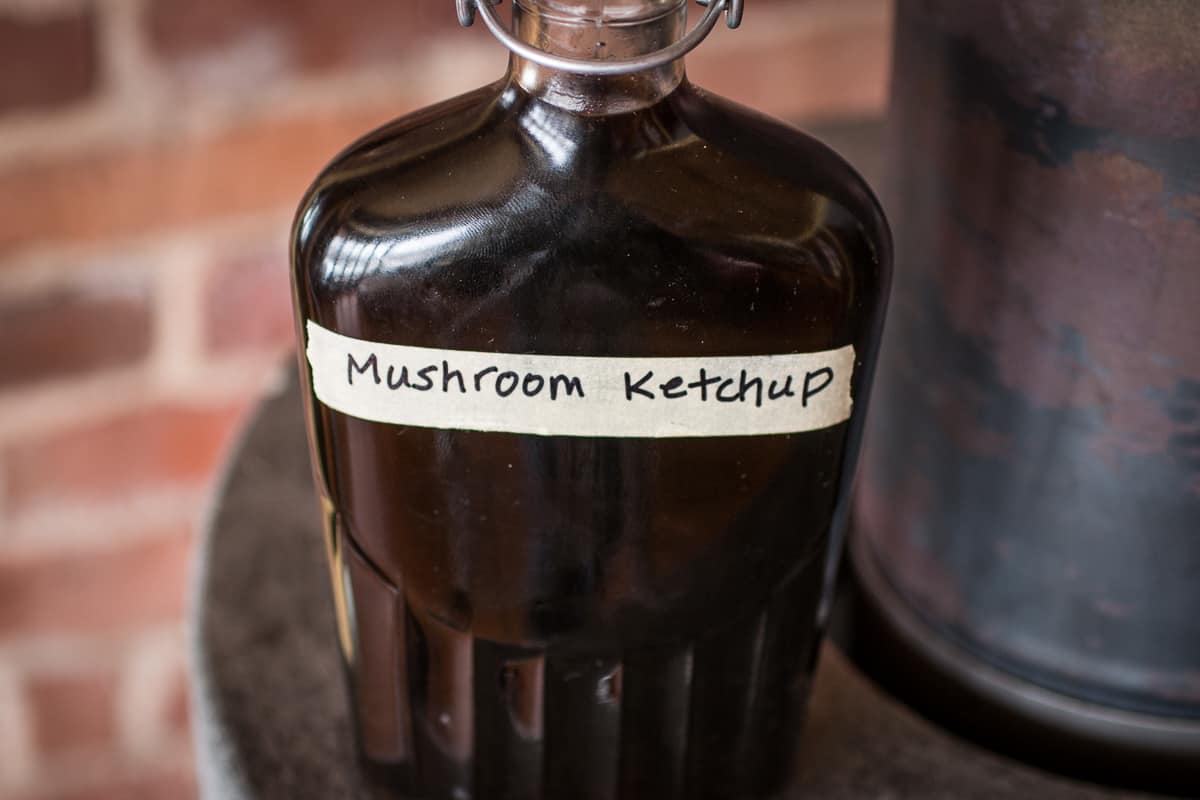
Have you ever run up to a massive chicken of the woods mushrooms or a hen, only to find it just a tiny bit past being good for the pan? Ever thought there might be something useful you could make with all the edible mushroom biomass you walk past, but pass up? Enter mushroom ketchup.
Mushroom ketchup is one of the original ketchups (also called catsups), all of which probably got their name from an Asian fish sauce called ketsiap. A couple hundred years ago, ketchup was basically a sort of catch all name for different liquid condiment, and you might have ketchups made from grapes, walnuts, or all kinds of different things.
Mushroom ketchup, is one, if not the best known (and still enjoyed) sauces in the family. I'd heard of it, as it's fairly well-referenced in cookbooks around the turn of the 20th century in a number of books I've read, but I didn't make my first batch until about 4 years ago, a time when I was going through 80-100 lbs of mushrooms a week--a great time to start working on a recipe.
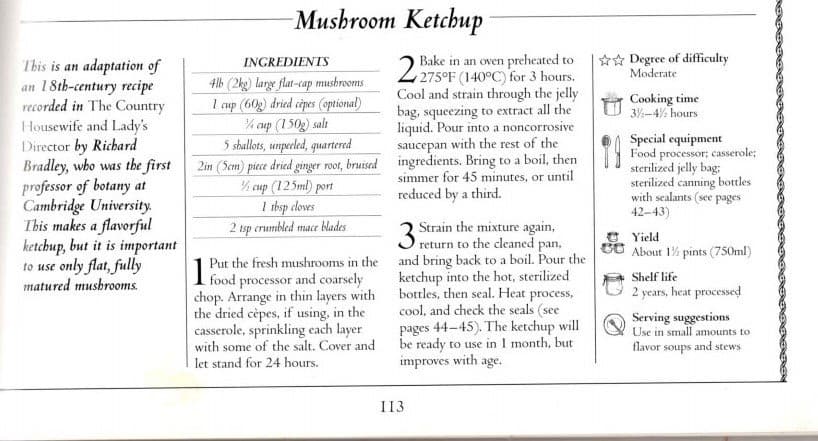
I'd seen the Townsend video many people reference now, and although I love historical cooking videos, there was a problem: at that time, there wasn't a single recipe online, and the only mushroom ketchup recipes I could find didn't include specific proportions of salt.
Let me tell you, seasoning to taste with salt, is fine, but something like "a few spoonfuls of salt" can be interpreted vary differently from one person to another (a pet-peeve chef tic of mine). One of my old line cooks made a ketchup from dryad saddles and, while it tasted excellent, it was so salty it made the water I used to chase it down taste sweet.
When making condiments, measuring your salt with a scale can mean the difference between something tasting ok, and your friends saying "you should bottle and sell that".
First, I ordered a bottle of commercial catsup online to gauge the flavor before I set off on my own. Then, for my first couple batches of mushroom ketchup, I had my cooks save the stems and season them with 3% of their weight in salt and leave them in the cooler.
After a couple weeks of collecting stems, I'd add some dried boletes (slippery jacks from Chile) along with some spices, then cook, puree, strain and bottle. It was really, really good. The mushroom flavor, even made from cheap boletes and buttons, was deeply mushroomy and rich, and hit the menu soon after in the form of cream of mushroom soup, using mushroom ketchup to underline the earthy flavors.
The only problem was that I ran out too fast, so I started ordering product specifically to make the sauce, which is when I developed the version I'm sharing with you today: a version by the mushroom hunter, for the mushroom hunter.
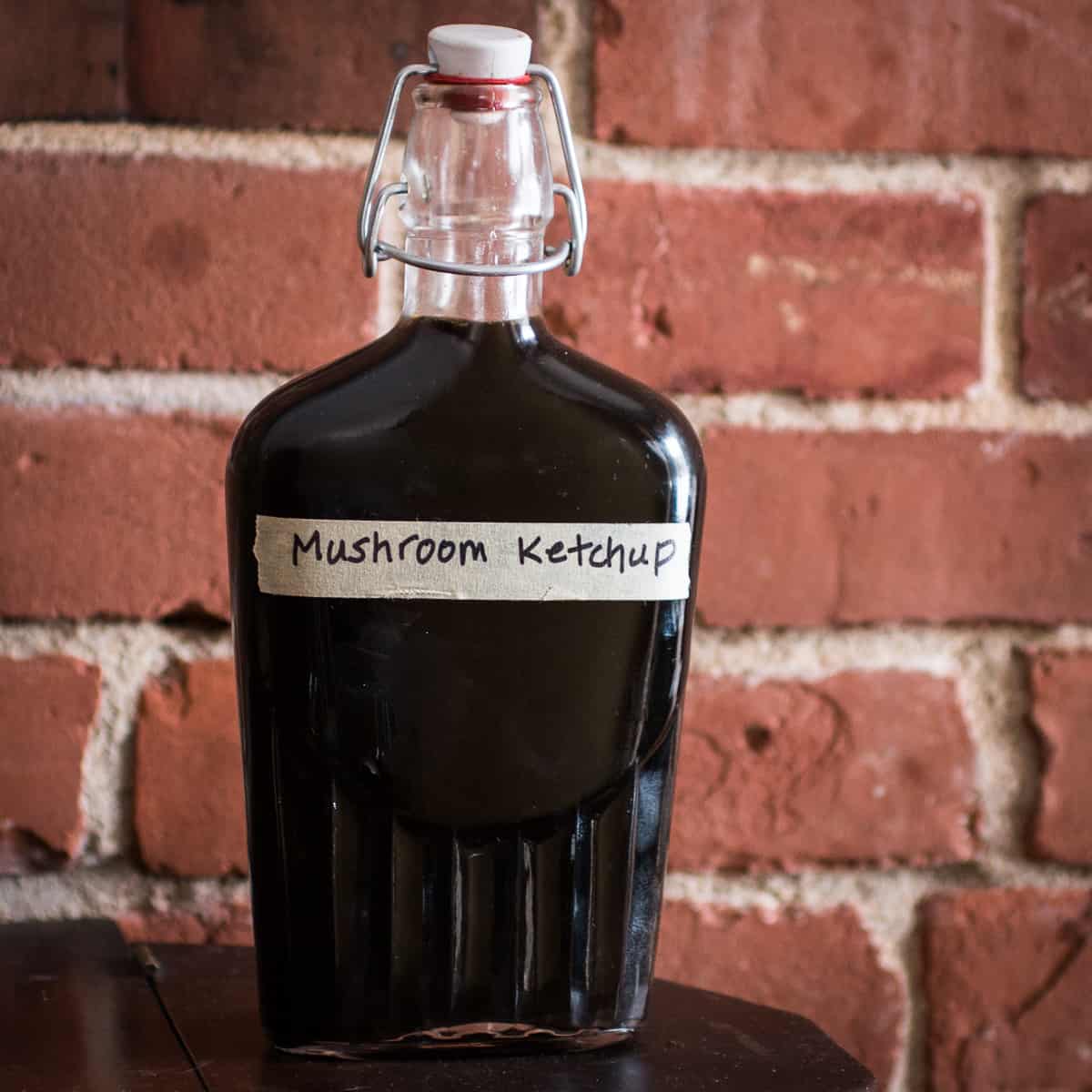
Here's some takeaways I've learned over the years:
Tips
- Don't use the pores of mature boletes. Bolete pores have a tendency to produce a gelatinous, viscous ketchup.
- Despite what other recipes will say online, don't puree the mushrooms. I like to pulse them in a food processor, or shred them through a food mill or food processor attachment. Pureeing will give you a cloudy finished sauce. That being said, it still tastes fine, and, you can always puree 4 cups with ½ teaspoon of xanthum gum to make a slightly thickened condiment--good in it's own right.
- Keep it in the fridge. Even though there's vinegar and salt, the salt is only a concentration of roughly 7-10% percent, where soy sauce is generally 16-20%. While it won't go rancid, I noticed some jars growing kahm yeast a few years ago, which while it won't hurt you, it can eventually create it's own flavors which isn't good. I've also had some jars feel pressurized and develop flavors of amonia, and although the flavor dissipated with cooking, it's still off-putting.
- Save the drained mushroom mash, dehydrate it, and use as a salt substitute. You can also dehydrate it, powder it, and add it back to the finished ketchup for a thicker, product, especially if you bind it with xanthum gum (see above).
- The best species is whatever large amount of fungus you have available. Common agarics, like the ones typically used in videos and online, can be difficult to source en-masse, but hens, chickens, and older boletes are great.
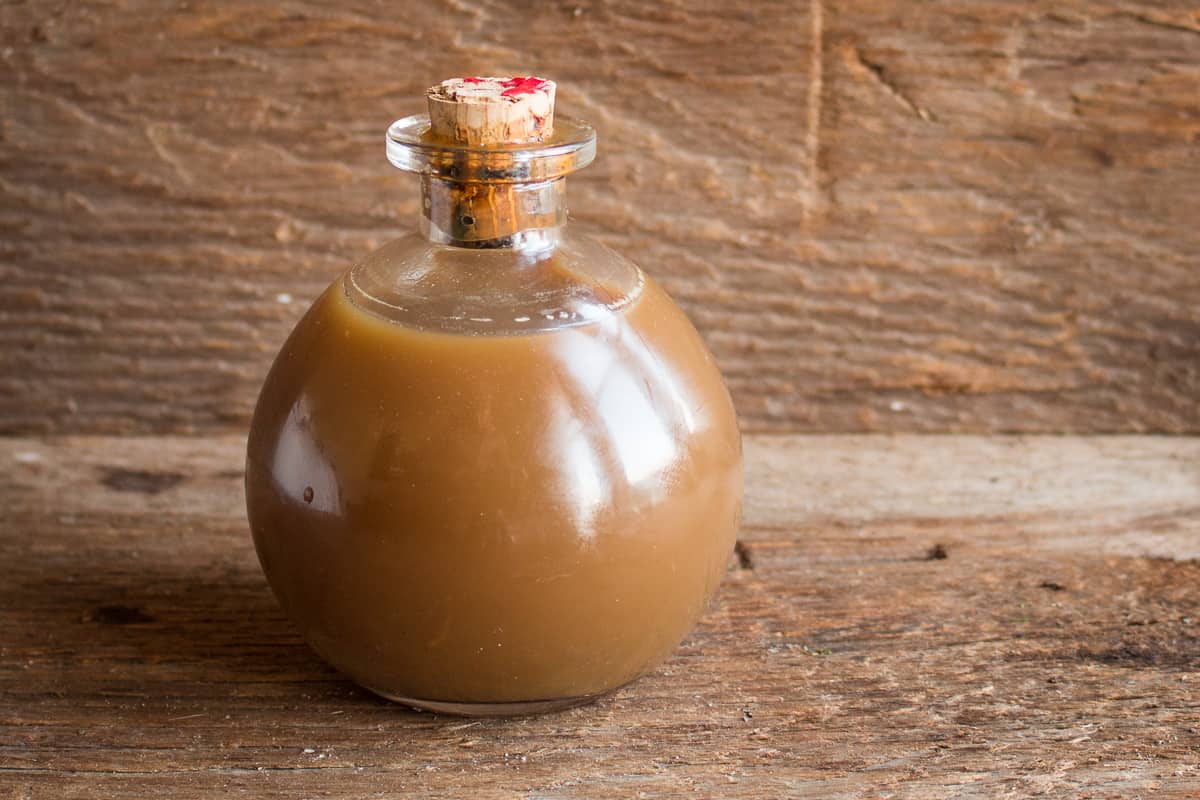
Use Ideas
I've done a lot of different things with the stuff over the years, but here's some favorites that won't fail you.
- Marinade. Season meat with a couple splashes a few hours or overnight before cooking. It will literally taste like mushroom flavored meat.
- Soy sauce substitute. Anywhere you would use soy sauce. See the image here with my shiitake egg rolls, or just use it as an excuse to eat a giant bowl of buttered rice.
- Fish sauce substitute. Use it in peanut sauce, kimchi, sweet and sour salad dressings, etc.
- Soups. Used in a soup, the ketchup will fade into the background (unless you use a ton of it) but it adds earthy undertones
- Sausages. There's still plenty of salt in this stuff, and salt (not seasonings) is what forms the myosin (the coagulative substance that gives sausage a good bite) Try using the ketchup in my puffball brat recipe.
- Pan sauce. This is one of the first things I read about using mushroom ketchup in, from the book A Taste of Scotland by Theodora Fitzgibbons. Cook some cutlets, deglaze the pan with a dash of wine, then add a splash of mushroom ketchup, and thicken the sauce lightly with roux, starch, or butter.
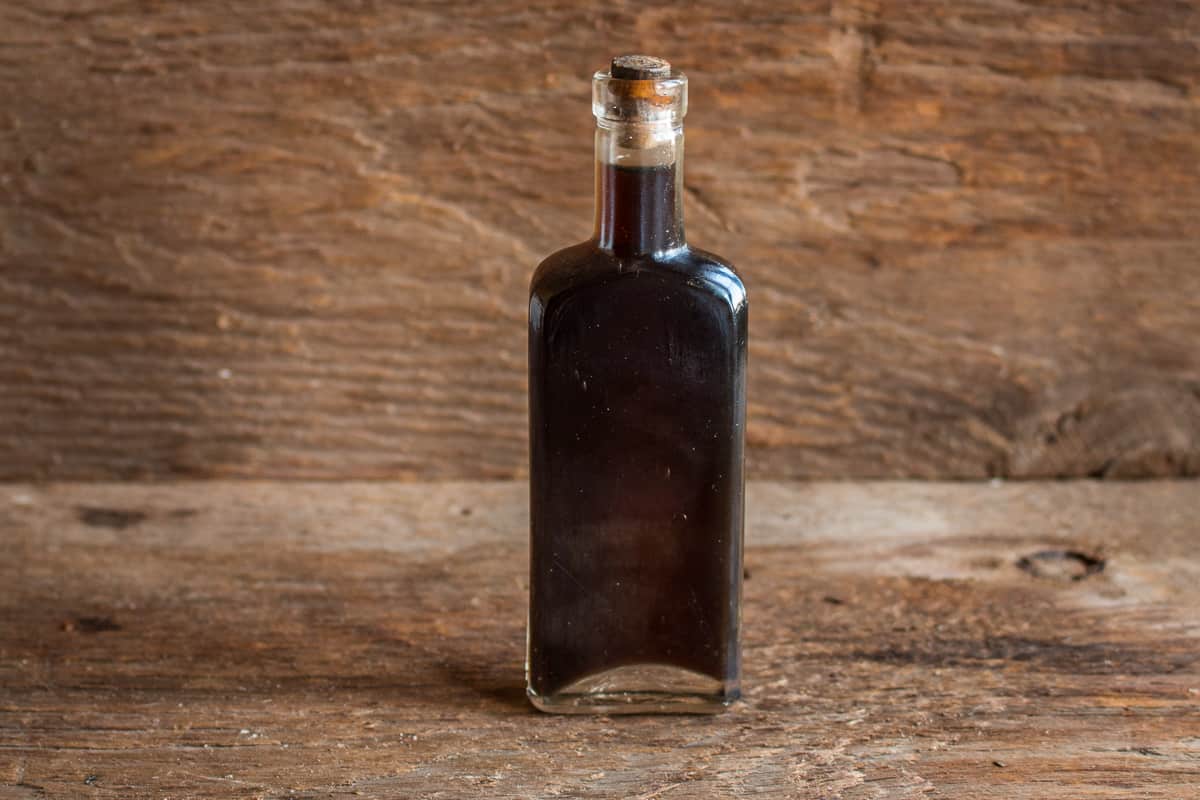
Variations
- Double ketchup. Reduce the finished ketchup down by half (or even a little less, like ⅓) for a salt concentration similar to soy sauce, and a richer, darker, flavor.
- Different species. Every species will taste a little different. For mushrooms that give off a light colored juice, omit the Worcestershire to keep the color pure.
- Thickened. You can thicken this by pureeing 4 cups with ¼ teaspoon of xanthum gum, or by using rice flour, starch, then cooking and pureeing, etc. A thickened ketchup is a more powerful condiment, since it's not as watery and will cling to food.
- No waste ketchup. Use 2.5 lbs of mushrooms instead of 5, and puree everything until smooth after you're done for a thick paste/condiment--excellent with pureed soups and sauces.
- With dried mushrooms. I used to add dried slippery jacks, porcini, or whatever I had when I could.
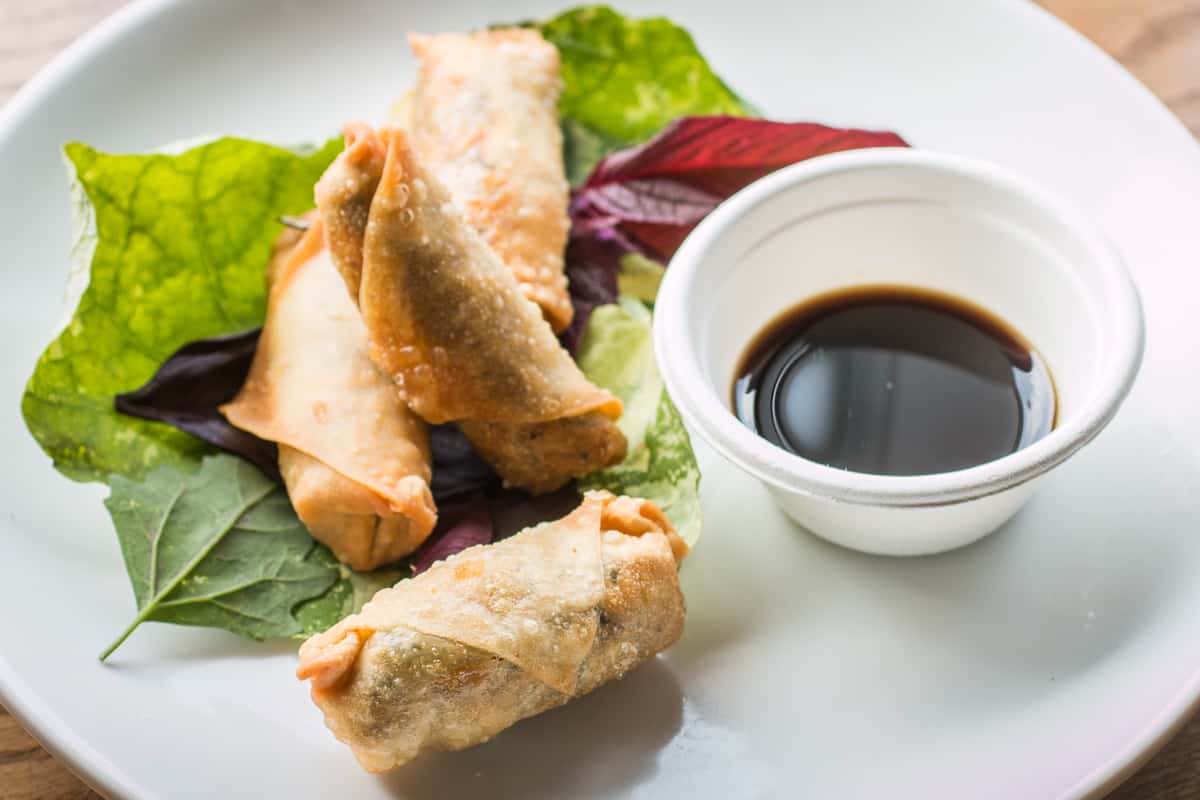
Wild Mushroom Ketchup
Equipment
- Large stock pot
- Cheesecloth or strainer
Ingredients
- 3-5 lbs wild or cultivated mushrooms, depending on availability trim, woody ends, etc.
- 85 grams roughly 6 tablespoons kosher salt
- 1 tablespoon ground black pepper
- Up to 2 qts water amounts of natural water in mushrooms will vary
- 2 Tablespoons minced garlic
- 2 fresh bay leaves
- 1 Tablespoons allspice berries toasted
- 2 Tablespoons chopped fresh ginger
- 1 teaspoon dried thyme
- 10 whole cloves toasted
- 2 tablespoon worchesterchire, or to taste optional, for color
- 1 cups apple cider vinegar or white wine, etc, use your favorite
Instructions
- Crush or chop the allspice and cloves. Pulse the mushrooms in a food processor, being very careful to coarsely pulse them in small batches, as over-processing will give a cloudy sauce.
- Combine the ground mushrooms with the salt and remaining ingredients except the water in a stock pot.
- Assess the amount of liquid, adding some of the water to moisten until the mixture is wet and slushy (dryer mushroom like polypores may take up to 1 qt of water, where boletes and cultivated mushrooms might take half that) Transfer the pot to a burner and bring to a boil, then turn off the heat and leave overnight to cool and infuse. Transfer it to a smaller container that will fit in your refrigerator overnight.
- The next day, warm the mushrooms and the liquid. Pour the mixture into a strainer lined with cheesecloth and allow to drain (you may need to work in batches. After the liquid has drained, squeeze the cheesecloth with a few handfuls of mushroom at a time to extract as much liquid as possible.
Reduce the liquid until roughly 4 cups remain (or
until you like the flavor, it should taste a bit like light soy) then pour into
a labeled container, chill and refrigerate until needed.- The ketchup will keep for a long time.

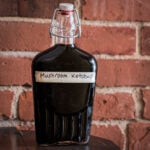
Michael
I made this with Winecaps from the garden. I used about 8lbs of mushrooms and got ~3 cups of sauce so the concentration maybe off. I noticed that as it sits in the fridge it separates into a clear, yellow liquid (~1/3rd volume) with a coagulated brown liquid (~2/3rd volume). Shaking vigorously mixes it fairly well, but not homogenously.
Is this normal or did I do something wrong?
Alan Bergo
This is normal to have some separation, and is part of why I put the soy in there. You will get variations in clarity and color from different species. Some are jet black, some are more opaque and loose or show separation. On another note, this is a great use of wine caps. Mine are always so buggy.
Kirk Hanson
I made a batch using fresh chanterelles we just harvested. I only added about 3 cups of water to the mushroom and spice mix as it became very slushy very quickly. I likely should have added more water, however, as the result was an extremely salty liquid. I'm debating diluting with more water. I'm also considering blending some of the mushroom/spice mash with the liquid to try to thicken it up. Do you have any suggestions for how to dilute and/or thicken the liquid?
Alan Bergo
It’s supposed to be salty. It has the same concentration of salt as most soy sauces. Try using it to season broth first. You can blend the sauce and add some water.
Brittany
I just found your website and recipe! I love it! I am not very experienced with mushroom recipes, but I am growing wine caps and just got my first big harvest. Do you think this recipe would work for wine caps? For older mushrooms, would I use just the caps or can I use the stem too? It would be nice not to waste the stems. Do I remove the gills?
Alan Bergo
This is a great recipe for wine caps.
Dayna Litowski
For some reason my memory of seeing a mushroom ketchup recipe thought i was to dehydrate the mushrooms first.
Do you think this recipe would work if i used dehydrated mushrooms?
I have hedgehogs and chantrelles
Thanks
Alan Bergo
It's not the same as the natural mushroom liquid is removed from them while they're drying. I'll be working on a dried version in the future but it will be a different process and finished product.
Dayna Litowski
Thanks for your reply. I ended up going out for a hike and found me a nice batch of mushrooms.
Made with chantrelles, winter chantrelles and hedgehogs. It turned out great! I dehydrated the leftovers after squeezing the sauce out of the cheese cloth, ground it uo, and am using it as a seasoning salt. So deeelish!!
I look forward to the dried mushroom recipe, as this year was amazing for mushrooms and we have dehydrated a lot.
Thanks
Alan Bergo
Thanks Dayna.
Tony Whitmore
Any suggestions on how to utilize the leftover mushroom mash after squeezing out liquid?
Alan Bergo
Dehydrate it and sprinkle like salt. Or add toasted sesame seeds, chili flakes, etc.
raabr
As someone who is super interested in mushroom ketchup but can't afford the means to get wild mushrooms, would button mushrooms function for this recipe, or would they lack the bite you'd want?
Alan Bergo
They'll work just fine! All the older recipes call for button mushrooms.
Phillip Hart
Excellent umami sauce. Since this is a savory sauce and contains disodium guanylate (GMT), couldn’t I replace some of the salt with MSG for the exponential boost GMT gives to MSG savoriness? I was thinking of using a few dried shiitake which have the most GMT and about 1 tbsp MSG.
Alan Bergo
Yes, the only problem is that salt is a preservative and extends the shelf life. You may run the risk of mold if it's reduced. Fine to try though.
Daniel bouchard
Just found a 14 lbs lions main and would like to try your recipe what do you think
Alan Bergo
Not the right mushroom for it. You want ones that will make a dark juice. I'd make my lions mane crabcakes
Joe johnston
I have an serious aversion to apple cider vinegar ...is there a workable substitute? Would white vinegar work or lemon juice?
Alan Bergo
Yes, the substitute is using your favorite vinegar. White wine is fine. Know that when vinegar is cooked it mellows.
David Britton
Because someone might use very moist, fresh mushrooms, I'd suggest a small edit. The Wild Mushroom Ketchup recipe says, "Combine the ground mushrooms with the salt and remaining ingredients except the water in a stock pot." I would now add," Leave overnight in cool place." Then you continue, "Assess the amount of liquid, adding some of the water to moisten ..."
Alan Bergo
I can see your point, but as the mushroom liquid is cooked afterward and reduced to a specific volume at the end it's a non-issue. I will say that variable water-content makes testing recipes applicable to different species pretty tricky sometimes. Thanks for chiming in.
Lorri
I halved this recipe and made this using maitake from last fall. I blanched and froze mushrooms and I kept and froze the blanching liquid. So I used the “broth” instead of water and omitted the Worcestershire sauce. It turned out to have a nice taste and color.
Also I couldn’t get myself to throw out the mushrooms so I made a soup/gravy to put over noodles, meat, or potatoes. So many ideas. Thank you for sharing your recipe.
Alan Bergo
Glad it worked for you Lorri!
Clifford Bradford
I made some in maitake season and it's been in the fridge but now it's gone to jelly, still tastes good but any idea what happened?
Alan Bergo
Try warming it to relax the congealed quality.
Cathy Judge
Hi there, thank you for posting this delicious recipe. I have been looking for a recipe that keeps for more than 3 months as it makes so much ipI ideally need it to last longer than that. You say it keeps a long time but how long roughly would you say?
Alan Bergo
If it is refrigerated or water bath processed, at least a year, probably longer. Treat like regular pickles as the acid / pH is very comparable.
Erin
Has anyone water bathed mushroom ketchup?
Alan Bergo
Hi Erin, yes, this is part of why there's vinegar in the recipe. It can definitely be water bathed and I have multiple jars made from different species on the shelf right now.
Elke
...I was about to ask the exact same question as Michael, since the honeys are flushing like crazy here in VT! Instead I'll ask, if I did want to save the mash and then dehydrate it to use as a spice/powder, would it need additional cook time before leaving to infuse? Or would the secondary dehydrating take care of any potential ill-effects from the honeys? As a!ways, thanks so much for sharing your knowledge and expertise.
Michael Braun Hamilton
Thanks for this! Would it work with honey mushrooms? Would it be important to cook them more thoroughly in the process?
Alan Bergo
It should work with honeys, but you may get some coagulation after you reduce the sauce. Not a big deal if you use it season soup or something. Safety is a non-issue as you are discarding the mushroom after cooking.
Doug
Made a small batch of this using bolete trimmings - very nice! One mistake I made was to not trim off the pores on the boletes. The result was slimy and somewhat gelatinous. Perhaps include.a reminder to do this.
I made a second batch with more bolete trimmings. This time I trimmed off all the pores, and it came out just fine - consistency is like soy sauce. I shifted the seasoning for the second batch too: Sichuan peppercorn, star anise, ginger, cinnamon, garlic, rice vinegar, and a little bit of mirin at the end since it needed sweetness to come together.
Also of note is how Black Velvet boletes produce a nice dark brown sauce without any Worcestershire.
Alan Bergo
Thanks Doug, I've added some tips to the post. Appreciate it!
Adam
Interestingly, I found the same to be true for Laetiporus sulphureus, even using primarily young/tender mushrooms -- the ketchup is delicious but quite gelatinous. Did you find this to be true for your COTW ketchup? Also, do you like to age at room temp?
Alan Bergo
No, age it in the fridge, unless you waterbath process it.
Michele
I like your idea of adding the Sichuan peppercorns and other spice combination! Going to try this with half a batch!! 👌
Alan Bergo
Yeah half batch is a good place to start for your first time.
Elke
Hi Chef,
I'm a longtime fan of your recipes & avid forager. I've been on a candy kick and just realized I only have one pound of black trumpets on hand for catsup. Can I divide this recipe by 3 and still be successful? Or better to go gather another couple pounds & make the whole thing? I don't mind only a small amount of finished product; not sure if the salt/acid amounts still work when halved (or...thirded?) Thanks!!!
Alan Bergo
Elke,
Sorry I was a little pokey here, it's been a crazy week for me. So, it is totally fine to scale this recipe up or down. The bigger thing I would mention here though is that you do not need all 5 lbs of the mushrooms to be precious trumpets. If I were you, I would use 1/3 trumpet and 2/3 whatever mushroom (crimini won't take over the flavor like shiitake would). Using all trumpets for this could make a slightly bitter sauce, but using a proportion of them should give you a fantastic color. Let me know if that makes sense.
Elke
Hi Chef Alan,
No worries, craziness abounds. I'm in East Central Vermont, and the trumpets are far from precious this year - my spots are literally /carpeted/ with them, all different varieties. (We've had an insanely wet season, so all the fungus is going nuts!). Fresh aside, I usually dry & ground the black trumpets for powder, so I'm familiar with the bitter aspect. Good to know though re proportions, I just picked a mixed half pound of edulis and ornatipes, so was planning to mix those in. It always takes a few trial runs to dial everything in anyway. 🙂
PS I've been playing with your candy recipe - a few leaves of monarda added to the meadowsweet & cleavers was really nice (I used a wild fermented Chardonnay; thinking about trying a rosé next...) but today's winner was regular chanterelles in that same syrup (reused from the black trumpets) & amended with a half tsp of fenugreek seeds and two Tbs of dark maple syrup. SO GOOD!
Alan Bergo
Elke, great. Yes with trumpets think of using them as a proportion here-they will add flavor, but more importantly they will help give it a dark, attractive hue that will look similar to my ketchup in this post. If you used, say, all ornatipes or porcini, it may be a brown sauce instead of the darker color. Use you imagination, and if you have lots of wild ones, great.
Cliff Bradford
Could you ferment it for a bit before refrigerating?
Alan Bergo
The salt content is high enough that I don't know if you'll get much lacto action. To ferment it at the salt concentration used here I would add a handful of koji rice, which would do the trick.
Chris Friedlieb
How about dried puffball? Would it get too gooey?
Alan Bergo
Hmmm. Fresh puffball would be preferable, but you could sure add some powder to a batch made with fresh mushrooms--just make sure to strain it through a coffee filter afterwords. I would also toast the powder before adding.
Jennifer
Hello Alan,
If the sauce is heated, can it be canned in a hot water bath, so I may preserve the batch I'm making? I imagine so. I just want your take on canning the mushroom ketchup.
Alan Bergo
Hey Jennifer, I haven't canned it myself as I would typically keep it in a restaurant cooler, but it should be fine, especially since it contains vinegar. Let me know how it works out for you.
Jenn
Between the salt content and acid content, there is no reasonable reason this would be unsafe to waterbath can. Botulism is suppressed by salt and by acid, and there's enough salt alone to suppress it without the vinegar, then you add the vinegar. Completely safe. 10 minutes processing
Marie Mason
Hi Alan,
Am I able to just use St George’s with this recipe or do you suggest adding more varieties?
Alan Bergo
Hi Marie, first, I'm jealous of your St. George. Secondly, you can use any mushroom here really, just keep in mind the juices of some are less dark and attractive than others, which is why I suggest adding worchesterchire as a colorant, which doesn't really affect the flavor.
Annegret Heikkinen
Thanks for the recipe, it sounds delicious! Since I want to use also dried parasoles and black trumpets my question is: would you reconstitute them first (saving the liquid to add later) before chopping them up? Or just throw them dried into the food processor along the fresh ones? Or crumble them in? Sorry if I just didn‘t get it and thank you for your answer!
Alan Bergo
Hey there, sorry for being pokey here. You can absolutely add dried mushrooms to your ketchup, and it will improve the flavor, like said, I used to add slippery jacks to my restaurant batches. Just crumble the mushrooms and add them to the fresh ones when you cook it. You don't want to soak them and save the liquid for something else--you want all that goodness in your sauce! Let me know how it turns out for you. Alan.
Glenn Freeman
Take a look at steps 5. and 6. I thuink you only meant one of them correct?
Alan Bergo
Hey Glen, thanks for the copy edit, you're correct.